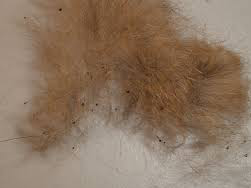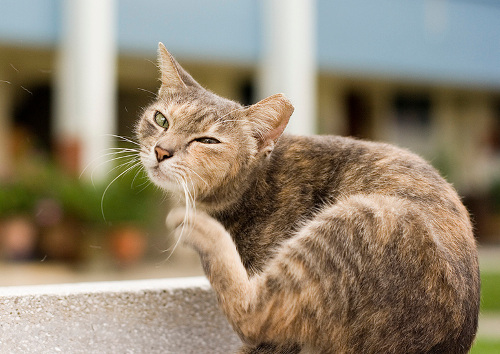“That can’t possibly be flea dirt” I thought to myself as I walked past my cat Molly’s bed, “I’m the vet, my cat can’t have fleas!” A wave of embarrassment washed over me as I realised that yes, my own cat had fleas. I had forgotten to apply her monthly flea preventative for the past 2 months and it turns out that just because she lives with a vet she isn’t magically immune to fleas. The truth is that fleas don’t care who you are, where you live or how clean your house is. If your cat goes outside, or if your house was previously lived in by cats who went outside, your cat can get fleas.
Molly is actually just one of many cats I’ve seen with fleas this month. Around this time of year we turn on the central heating, creating a warm and cosy home for ourselves and our cats. The problem is that we’re not the only ones enjoying this warm home environment – the extra heat re-activates the fleas’ lifecycle and brings them out of hiding. Unfortunately many cat owners either knowingly or unknowingly stop applying monthly flea treatments once it gets colder outside and suddenly they’re left with a very itchy kitty.
Did you know…
- An adult flea can attach to a new host within 2 seconds of emerging from its cocoon, but if no host is found it can stay safely cocooned for up to 2 years
- Fleas can jump up to 150 times their own length, and consume 15 times their own body weight in blood daily
- A female flea can lay about 50 eggs a day and once these new fleas mature, they can each bite up to 400 times a day
How do you know if your cat has fleas?

You may see your cat start to bite and scratch at themselves, sometimes frantically chewing at the site of a flea bite. Or perhaps you might notice scabbing along their back and neck. If your cat sleeps in the same place each day, you might also notice tiny specks of red/brown debris in their bed or in their fur. These specks are called ‘flea dirt’ and are actually the faeces of the fleas after they feed on the cat’s blood. If you’re not sure whether your cat has flea dirt or dirt from the garden, try rubbing the little specks into some wet white paper or tissue – if it leaves a red/brown smudge, it’s flea dirt.
How do you get rid of fleas?

There are countless products out there that kill fleas. It is, however, very important that you choose one that won’t also kill your cat. NEVER APPLY A FLEA TREATMENT MEANT FOR DOGS TO YOUR CAT as it may contain permethrin, a substance that is deadly to cats. You can find all sorts of products on the market from sprays, powders and shampoos to tablets and collars to natural remedies and spot-on products that go on the back of the neck. It’s easy to waste lots of money and time on products from the internet or the supermarket that may or may not work so do yourself and your cat a favour – speak with your vet and get a feline-friendly flea preventative that will do the job right the first time. Whatever you choose, read all instructions carefully before using it on your cat.
Even the best flea products can’t kill all stages of the flea’s lifecycle in a single dose, so repeat application is necessary in most cases. Cat fleas can take up residence in your carpets, floorboards or furniture, hiding out of sight until your cat walks by and they can hop on for their next meal. It’s important to keep applying the monthly preventative for at least several months and ideally year-round to catch and kill fleas in every stage of their lifecycle. You will probably also have to treat the environment itself by washing bedding at a high temperature and vacuum cleaning all furniture and flooring, paying particular attention to dark cracks and crevices. If the infestation is particularly bad, you may need to chemically treat the house but clearly it’s best to prevent this from happening in the first place.
Sure, fleas are unpleasant, but are they dangerous?
Some cats are more sensitive to flea bites than others, resulting in significant flea allergy dermatitis that needs to be treated by the vet. Young kittens can be so badly infested that they become anaemic through blood loss and die. Even cats that don’t seem that itchy can still pick up some nasty flea-transmitted diseases like Bartonella, an organism that can cause not only significant illness in your cat, but also you and your family (ever heard of ‘cat scratch fever’?). And if all that wasn’t bad enough, fleas carry tapeworms so all cats should receive a tapeworm treatment once the infestation is under control.
If your cat has fleas, don’t ignore the problem as it will only get worse. Quickly.
Resources
For more information about fleas, check out the following resources:
- International Cat Carehttps://icatcare.org/advice/fleas-and-flea-control-in-cats/ — International Cat Care’s fact sheet on fleas and flea treatments.
- Cornell University Feline Health Centerhttps://www.vet.cornell.edu/departments-centers-and-institutes/cornell-feline-health-center/health-information/feline-health-topics/fleas-source-torment-your-cat — Flea facts from Cornell’s feline experts.


